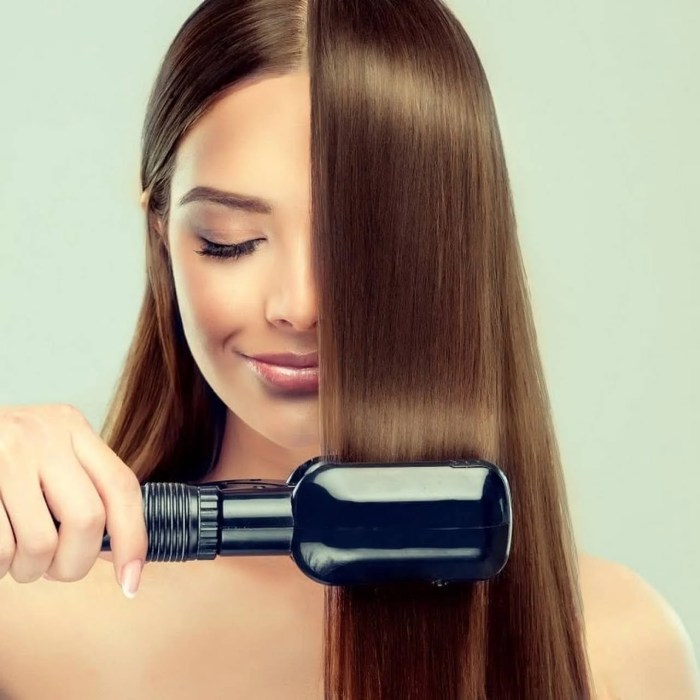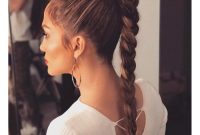Are you tired of your curly or wavy hair and dream of sleek, straight locks? Hair straightening treatments can make your dream a reality! With various options available, it’s crucial to understand the types and their pros and cons to make an informed decision for your hair.
In this guide, we’ll delve into the world of hair straightening treatments, providing you with comprehensive information to help you achieve your desired hair goals. We’ll explore the top 3 straightening treatments, their benefits, maintenance tips, and more, empowering you to make the best choice for your hair.
Introduction to Hair Straightening Treatments
Hair straightening treatments are a popular way to achieve smooth, sleek hair. They can be used to tame frizz, reduce curl, and make hair more manageable. There are several different types of hair straightening treatments available, each with its own benefits and drawbacks.
One of the most popular hair straightening treatments is the Brazilian blowout. This treatment uses a keratin-based solution that is applied to the hair and then sealed in with a flat iron. The Brazilian blowout can last for up to three months and can leave hair looking smooth and shiny.
However, it can also be expensive and can damage hair if it is not done properly.
Types of Hair Straightening Treatments

Hair straightening treatments can be broadly categorized into two main types: chemical treatments and heat treatments. Each type offers its own unique set of advantages and disadvantages, depending on the desired results and the condition of the hair.
Chemical Treatments
Chemical hair straightening treatments involve the use of chemicals to alter the structure of the hair, resulting in a permanent or semi-permanent straightening effect. There are two main types of chemical straightening treatments: relaxers and keratin treatments.
Relaxers
- Relaxers contain chemicals, such as sodium hydroxide or calcium hydroxide, that break down the bonds in the hair, causing it to become more pliable and easier to straighten.
- Relaxers are typically used on curly or coily hair to achieve a straighter texture.
- While relaxers can be effective in straightening hair, they can also be harsh and damaging, especially if not applied correctly.
- Regular touch-ups are necessary to maintain the straightened hair, as new hair growth will be curly or coily.
Keratin Treatments
- Keratin treatments use a protein called keratin to coat the hair, smoothing the cuticle and reducing frizz.
- Keratin treatments are less damaging than relaxers and can be used on a wider range of hair types, including color-treated hair.
- Keratin treatments typically last for several months, but they can be expensive and require regular maintenance.
- Keratin treatments can also make hair appear flatter and less voluminous.
Heat Treatments
Heat treatments use heat to straighten hair temporarily. Heat tools, such as flat irons and blow dryers, can be used to achieve a variety of straightening styles, from sleek and straight to loose and wavy.
Flat Irons
- Flat irons use two heated plates to press the hair, flattening the cuticle and straightening the hair.
- Flat irons can be used on all hair types, but they can be damaging if not used correctly.
- It is important to use a heat protectant spray before using a flat iron to minimize damage.
- Flat irons can be used to create a variety of straightening styles, from sleek and straight to loose and wavy.
Blow Dryers
- Blow dryers use hot air to dry and straighten hair.
- Blow dryers can be used on all hair types, but they can be less effective on thick or curly hair.
- It is important to use a heat protectant spray before using a blow dryer to minimize damage.
- Blow dryers can be used to create a variety of straightening styles, from sleek and straight to loose and wavy.
Choosing the Right Treatment for Your Hair

Selecting the optimal hair straightening treatment requires careful consideration of your unique hair characteristics. Factors such as hair type, texture, and desired results play a crucial role in determining the most suitable treatment.
It’s highly recommended to consult with a professional hairstylist who can assess your hair’s condition and provide personalized recommendations. They can guide you through the various treatment options, explaining their benefits, limitations, and suitability for your specific hair needs.
Factors to Consider
- Hair Type: Straightening treatments are designed for different hair types, including fine, medium, or coarse hair. Choosing a treatment that is appropriate for your hair’s thickness and density ensures optimal results.
- Hair Texture: The texture of your hair, whether it’s naturally curly, wavy, or straight, influences the effectiveness of straightening treatments. Treatments vary in their ability to tame frizz, define curls, or achieve a sleek, straight look.
- Desired Results: Clearly define your desired outcome before selecting a treatment. Some treatments provide temporary straightening, while others offer long-lasting or permanent results. Consider the duration and level of straightening you wish to achieve.
Top 3 Hair Straightening Treatments
Embrace sleek, frizz-free locks with these top-rated hair straightening treatments. Each method offers unique benefits and considerations to cater to different hair types and desired results.
Keratin Treatment
Keratin treatments infuse hair with a protein called keratin, naturally found in hair. This protein strengthens and smoothes hair, reducing frizz and enhancing shine.
- Benefits: Long-lasting results (up to 6 months), tames frizz, improves hair texture, and protects against damage.
- Process: A keratin solution is applied to hair, then heat is used to seal it in. Treatment takes several hours.
- Cost: $200-$500+
- Maintenance: Sulfate-free shampoos and conditioners recommended. Avoid harsh chemicals or heat styling.
- Longevity: Up to 6 months with proper care.
Japanese Hair Straightening
Japanese hair straightening permanently alters the hair’s structure using a chemical solution. This treatment is highly effective in achieving pin-straight results.
- Benefits: Permanent results, extreme straightening, suitable for all hair types.
- Process: A chemical solution is applied to hair, followed by heat and a neutralizing agent. Treatment takes several hours.
- Cost: $300-$600+
- Maintenance: Regular trims to remove new hair growth.
- Longevity: Permanent, but hair may revert to its natural texture over time.
- Cons: Can be harsh on hair, causing damage if not done properly. Not recommended for chemically treated or damaged hair.
Brazilian Blowout
Brazilian Blowouts use a formaldehyde-based solution to smooth hair, reducing frizz and adding shine. This treatment is less permanent than other methods.
- Benefits: Smooths frizz, adds shine, reduces blow-drying time.
- Process: A formaldehyde-based solution is applied to hair, then heat is used to seal it in. Treatment takes 1-2 hours.
- Cost: $150-$300
- Maintenance: Sulfate-free shampoos and conditioners recommended.
- Longevity: 3-4 months, depending on hair type and care.
Maintenance and Care for Straightened Hair

Maintaining and caring for straightened hair is crucial to keep it healthy and prevent damage. Here are some essential tips:Proper washing is vital. Use sulfate-free shampoos and conditioners designed for straightened hair. Avoid washing too frequently, as it can strip away natural oils.Styling
should be done with care. Use a wide-tooth comb to detangle hair and avoid brushing when wet. Heat styling should be kept to a minimum and always use heat protectant spray.Heat protection is essential. Always apply a heat protectant spray before using heat styling tools to prevent damage and maintain hair’s integrity.
Hair Masks and Deep Conditioners
Regularly using hair masks and deep conditioners is highly beneficial. These treatments provide intense nourishment and hydration, restoring hair’s strength and shine. Choose products specifically formulated for straightened hair.
Leave-in Treatments
Leave-in treatments offer continuous protection and nourishment. They help detangle hair, reduce frizz, and provide heat protection. Apply leave-in treatments after washing and towel-drying hair.
Final Thoughts
Choosing the right hair straightening treatment can transform your hair, giving you the smooth, sleek locks you’ve always wanted. By considering your hair type, desired results, and budget, you can find the perfect treatment to achieve your hair goals. Remember to follow the maintenance tips and consult with a professional hairstylist for personalized advice to ensure healthy, beautiful hair.
Frequently Asked Questions
What is the difference between chemical and heat straightening treatments?
Chemical treatments use chemicals to alter the hair’s structure, making it straighter. Heat treatments, on the other hand, use heat tools like flat irons and blow dryers to straighten the hair temporarily.
Which hair straightening treatment is the most permanent?
Japanese hair straightening is considered the most permanent hair straightening treatment, with results lasting up to 6 months or longer.
Can hair straightening treatments damage my hair?
Some hair straightening treatments, especially chemical ones, can cause damage to the hair if not done properly or overused. It’s important to follow the instructions carefully and consult with a professional hairstylist to minimize the risk of damage.
How often can I get a hair straightening treatment?
The frequency of hair straightening treatments depends on the type of treatment and the growth rate of your hair. Chemical treatments typically last several months, while heat treatments need to be repeated more often, as the effects are temporary.
What are some tips for maintaining straightened hair?
To maintain straightened hair, use sulfate-free shampoos and conditioners, avoid excessive heat styling, and apply heat protectant sprays before using heat tools. Regular deep conditioning treatments and trims can also help keep your hair healthy and prevent damage.



